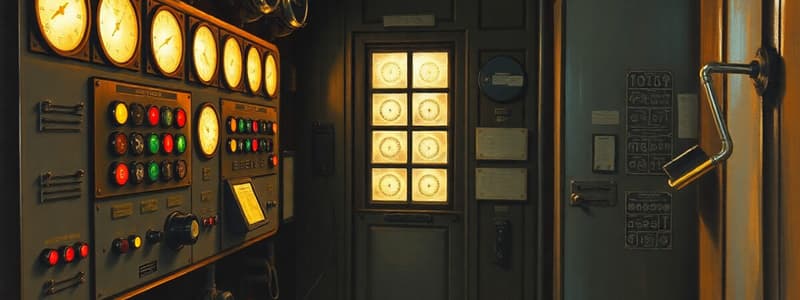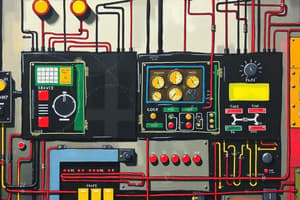Podcast
Questions and Answers
What color indicates that the crank handle is locked and the CH key is in position?
What color indicates that the crank handle is locked and the CH key is in position?
Yellow Steady
What indication does the control panel provide when the CH key is released but remains inserted?
What indication does the control panel provide when the CH key is released but remains inserted?
Red Flashing
What mechanism should be in place to prevent excessive current damage to indication lamps?
What mechanism should be in place to prevent excessive current damage to indication lamps?
Return wires must be suitably bifurcated.
What visual cue is given when a route cancellation is initiated during an approach locked condition?
What visual cue is given when a route cancellation is initiated during an approach locked condition?
When the gate is closed and locked, what color is the control panel indication?
When the gate is closed and locked, what color is the control panel indication?
What should occur if a push button on the control panel is left pressed?
What should occur if a push button on the control panel is left pressed?
Describe the indication when the emergency CH key release control is activated.
Describe the indication when the emergency CH key release control is activated.
What light condition indicates that the gate is open?
What light condition indicates that the gate is open?
What is the purpose of lighting the more restrictive aspect automatically in case of main signal failure?
What is the purpose of lighting the more restrictive aspect automatically in case of main signal failure?
Explain the implication of not being able to clear a signal in the rear if the ON aspect fails.
Explain the implication of not being able to clear a signal in the rear if the ON aspect fails.
What types of locking are mentioned as necessary for circuit design?
What types of locking are mentioned as necessary for circuit design?
What is required regarding the communication of point control relays before a signal displays an 'OFF' aspect?
What is required regarding the communication of point control relays before a signal displays an 'OFF' aspect?
Why are starter signals automatically replaced to 'ON' after the passage of a train?
Why are starter signals automatically replaced to 'ON' after the passage of a train?
Describe the locking condition for main signals concerning level crossing gates.
Describe the locking condition for main signals concerning level crossing gates.
What conditions must be met before opening an interlocked gate at a station?
What conditions must be met before opening an interlocked gate at a station?
How do advanced starter signals function differently at way side stations compared to junction stations?
How do advanced starter signals function differently at way side stations compared to junction stations?
What is the purpose of back locking in gate signals?
What is the purpose of back locking in gate signals?
Explain why isolation points of catch sidings may operate automatically.
Explain why isolation points of catch sidings may operate automatically.
How does the CH/NX control affect point operations?
How does the CH/NX control affect point operations?
What safeguards are in place to prevent false indications in point control circuits?
What safeguards are in place to prevent false indications in point control circuits?
Describe the actions triggered by failures in point zone track circuits.
Describe the actions triggered by failures in point zone track circuits.
Why are keys controlling hand-operated points electrically locked?
Why are keys controlling hand-operated points electrically locked?
What is the role of the time lag in cutting off motor feed for point movements?
What is the role of the time lag in cutting off motor feed for point movements?
What minimum interlocking is required between points according to the principles outlined?
What minimum interlocking is required between points according to the principles outlined?
Flashcards
Main signal aspect failure
Main signal aspect failure
If the light on a main signal fails, a more restrictive signal aspect should automatically illuminate.
Starter signal release at junction station
Starter signal release at junction station
Starter signals are released by advanced starters at junction stations, but not at wayside stations with single/double line block and fully circuited tracks.
Automatic signal replacement
Automatic signal replacement
Signals automatically switch back to "ON" after a train passes, with a delay for starter signals per the table.
Level crossing gates and main signals
Level crossing gates and main signals
Signup and view all the flashcards
Level crossing gate opening condition
Level crossing gate opening condition
Signup and view all the flashcards
Signal interlocking
Signal interlocking
Signup and view all the flashcards
Fouling protection
Fouling protection
Signup and view all the flashcards
Aspect indication
Aspect indication
Signup and view all the flashcards
Crank Handle (CH) Locked Status
Crank Handle (CH) Locked Status
Signup and view all the flashcards
Crank Handle (CH) Released (Not Extracted)
Crank Handle (CH) Released (Not Extracted)
Signup and view all the flashcards
Crank Handle (CH) Extracted
Crank Handle (CH) Extracted
Signup and view all the flashcards
Emergency CH Release with Timer
Emergency CH Release with Timer
Signup and view all the flashcards
Signal Lock Indication Flashing
Signal Lock Indication Flashing
Signup and view all the flashcards
Push Button Buzzer Indication
Push Button Buzzer Indication
Signup and view all the flashcards
Gate Closed/Locked Indication
Gate Closed/Locked Indication
Signup and view all the flashcards
Gate Opening Indication
Gate Opening Indication
Signup and view all the flashcards
Point Control Circuits
Point Control Circuits
Signup and view all the flashcards
Points remain in last position
Points remain in last position
Signup and view all the flashcards
Isolation points operation
Isolation points operation
Signup and view all the flashcards
Point operation after CH/NX control release
Point operation after CH/NX control release
Signup and view all the flashcards
Point operation when interlocking is free
Point operation when interlocking is free
Signup and view all the flashcards
Emergency point operation
Emergency point operation
Signup and view all the flashcards
Minimum Interlocking
Minimum Interlocking
Signup and view all the flashcards
Point control circuit design
Point control circuit design
Signup and view all the flashcards
Study Notes
Design Criteria of Signalling Circuits
- Detailed circuit designs may be required for route setting (Entry/Exit principle) or non-route setting (individual point operations) installations, or alterations.
- Designs must meet requirements for 25 kV AC electrified areas (Chapter 22 of SEM).
- Designs adhere to approved signalling plans, control tables, control panel diagrams, and relay analyses.
- Designs accommodate specific equipment types (distributed/central electronic interlocking, MSDAC, SSDAC, UFSBI, etc.) and interfacing features.
- Use of dual OFC cables in distributed electronic interlocking is preferred for reduced copper cable extent and alternate failure paths.
- Drawings and designs follow typical templates, RDSO standards, industry best practices, and reliability, availability, maintenance, and safety guidelines.
Control Panels - General
- Illuminated diagram layouts on control panels should be well-proportioned, using domino panels for potential future expansions, and distinguished areas by color.
- Operating members (route switches, buttons, point switches, etc.) are usually shown on the illuminated diagram itself in geographical order.
- Separate diagrams for indication and operating member consoles are sometimes provided.
- Installations that aren't route-setting type allow for individual point operation.
- Route setting is based on the "Entry/Exit" principle.
- Each route has two push buttons: one at the entrance and one at the exit.
Non-route Setting Installations
- Individual push button operation clears signals, possibly with group buttons or a common switch for conflicting signals (entrance/exit).
- Separate individual push buttons or two/three position switches for control of individual points are provided,
- Route selection with alternate routes/approaches is allowed.
Control Panel Indications
- Individual point operation arrangements are provided.
- Emergency operation of points, where provided, records operations on a counter.
- Facility for slotting, cabins, crossings, and crank handles is needed.
- Cancellation of slots, with a delay, uses a cancellation button with an entrance/exit button.
- Operation recording for slots and cancellation is provided by a counter.
- 'ON'/'OFF' operated signal positions from the panel cannot be changed after the SM key is removed, though the signal can be returned to 'ON' position without altering route.
- Indication of yard and critical maintenance information is presented.
- Point positions are indicated by lights (white/yellow/green).
- Point locking indication is provided by a small white light.
- Route settings and locking are shown by white lights on sections.
- Occupied track circuits are shown by red lights.
- Power supply status indications are provided.
- Approach track circuits are indicated.
- Advance approach warnings use flashing lights or other indications with audible warnings.
- Signal lamp failures alarm by red indication and audible alert.
- Indication of aspects for the corresponding signal in the 'OFF' mode.
- Failure conditions or status of aspects are shown with flashing indications.
- Shunt signal aspects are shown by a white strip light (horizontal).
- 'A'/'AG' marker light indications are provided.
Track Circuit Indications
- Indication of occupied track circuits using a row of red lights.
- Red lights extinguish when tracks are not occupied.
Other Crucial Aspects
- Detailed signal circuit design for 25kV AC electrified areas.
- Non-use of common return wires in critical circuits.
- Limitation on number of metal-to-metal relay contacts (45 max).
- Design mandates route setting interlocking for new installations.
- Correct point settings, overlap, and isolation are critical during route setting.
- Proper clearance for slot, road traffic, and overlap is handled by signal clearance.
- Requirements for clearing Calling-On and shunt signals are noted.
- White indication is required for Block control on the last stop signal when used in Absolute Block Systems.
- Other conditions for the Non-Route setting type are mentioned in the text.
- Specific conditions for route release circuits are noted..
Additional Signal and Control Information
- Procedures, controls, and key aspects for route control, point operation, signals, and other related aspects are detailed for both route-setting and non-route-setting types of installations
Electronic Devices
- The equipment design includes features to self-detect component failures and ensure signal display of most restrictive indications.
- Safety measures are in place to handle open/short circuit conditions and variations in component values.
- Physical layout prevents external objects from causing short circuits.
Track Circuits & Axle Counters
- Standardized train detection procedures using track circuits and axle counters are followed.
- DC track relays are centrally located.
- Extensive track circuiting is done to cover the station section
Signalling Cables
- Provisions for signalling cables conform to associated standards.
- The yard requires extra cable pairs for maintenance considerations, especially during expansions.
- Earth leakage detectors are recommended.
Point Machines Operation
- Crank hand operation with distinct group wards is considered.
- Safety mechanisms and controls for point operation are considered.
Advanced Aspects of Interlocking
- Features for Advanced Starter at Junction Stations, including the automatic resetting of signals based on train passage and controlled delays, are examined
- Special considerations for level crossings, including locking and signals, are detailed.
Signal Control Circuits aspects
- Conditions for setting and locking signals in route-setting, as well as non-route-setting installations, are explained.
- Consideration of procedures for clearing signals when conditions meet the requirements for specific types of signals are noted.
- Instructions on handling and restoring signals in emergency situations are provided to ensure safety
Studying That Suits You
Use AI to generate personalized quizzes and flashcards to suit your learning preferences.




